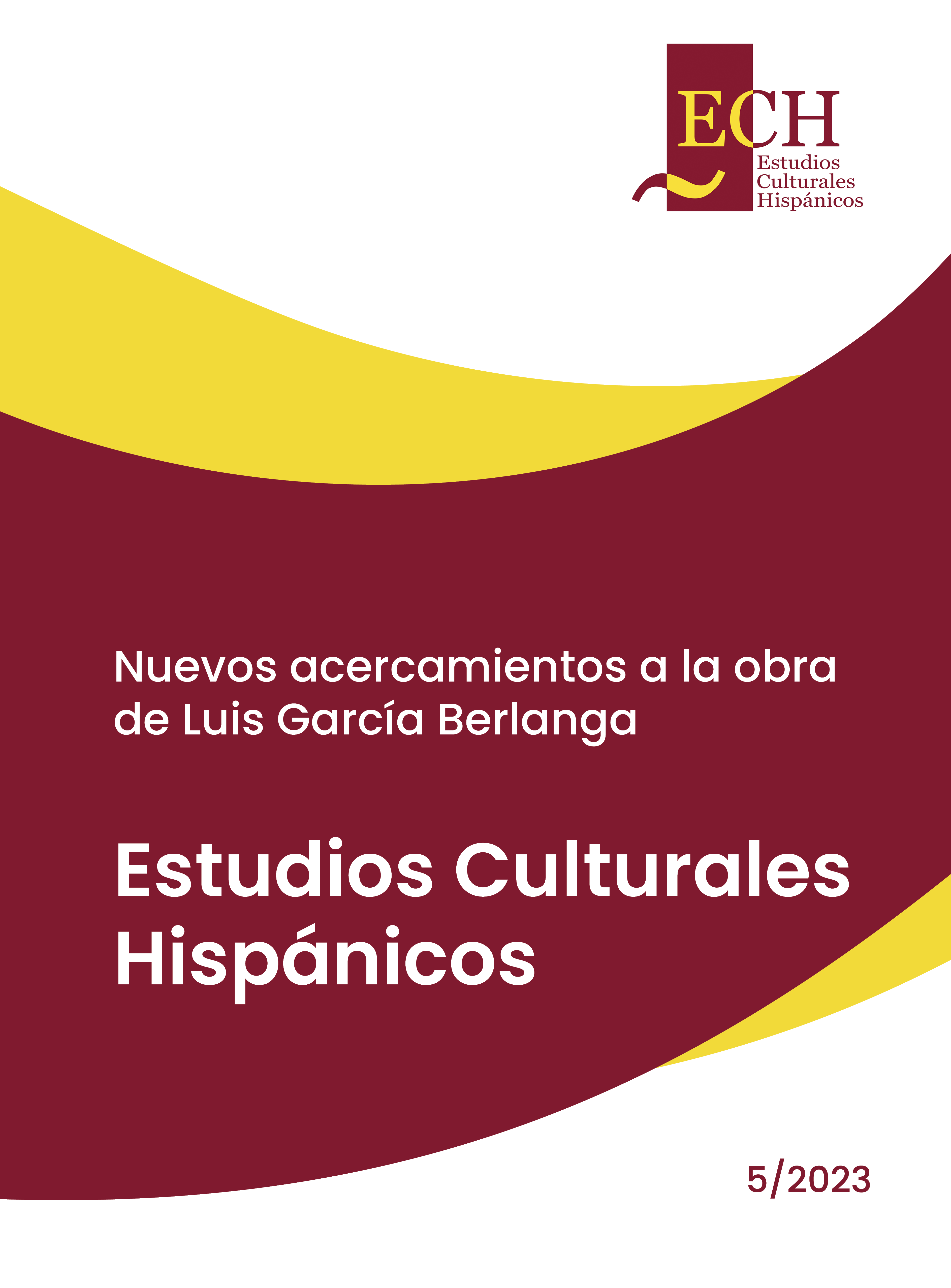EE. UU. y España. El cine de Berlanga y las producciones internacionales de los años 50 y 60
DOI:
https://doi.org/10.5283/ech.90Palabras clave:
runaway productions, poder blando, americanización, movilidad, motorizaciónResumen
La llegada de las así llamadas runaway productions a España a partir de los años cincuenta fue paralela al acercamiento político entre EE. UU. y el régimen franquista y dio lugar a una coexistencia históricamente única de las industrias cinematográficas española y norteamericana. Desde el principio, Francisco Franco intentó utilizar estas producciones para la autorrepresentación del país, principalmente con títulos que trataban de la historia española (por ejemplo, The Pride and the Passion) o de la nueva relación entre España y Estados Unidos (por ejemplo, Spanish Affair o It started with a Kiss). Si estas películas muestran así una multicodificación ideológica, se prestan a una lecture croisée con las obras de Berlanga de esos años, en las que los EE. UU. son también un tema central. A través de los aspectos estructurales (argumento y espacio) y los focos temáticos (movilidad, progreso técnico, imágenes de hombres y mujeres), tal comparación permite iluminar el complejo discursivo EE. UU. – España desde perspectivas divergentes y determinar con mayor precisión la posición de Berlanga dentro del mismo.
As the so-called runaway productions began to shoot films in Spain from the 1950s onwards, this ran parallel to the political rapprochement between the USA and the Franco regime and led to a historically unique coexistence of the Spanish and US film industries. From the very beginning, Francisco Franco tried to use such films for the country’s self-representation, primarily with titles that dealt with Spanish history (e.g. The Pride and the Passion) or with the new relationship between Spain and the USA (e.g. Spanish Affair or It started with a Kiss). If these films thus exhibit an ideological multicoding, they lend themselves to a lecture croisée with Berlanga’s works of those years in which the USA is also a central theme. Putting structural aspects (plot and spatial structures) and thematic focal points (mobility, technical progress, images of men and women) in the forefront such a comparison makes it possible to illuminate the discourse complex USA – Spain from divergent perspectives and to determine Berlanga’s position within it even more precisely.
Citas
Albrecht, Gerd (1970). Film im Dritten Reich. Karlsruhe: Doku-Verlag.
Asión Suñer, Ana (2022). La Tercera Vía del cine español. Espejo de un país en trasición. Barcelona: Laertes.
Bernecker, Walther L. / Brinkmann, Sören (2006). Kampf der Erinnerungen. Der Spanische Bürgerkrieg in Politik und Gesellschaft 1936–2006, Nettersheim: Verlag Graswurzelrevolution.
Bernstorff, Madeleine (2003). “Spanish Affair. Flamenca – Ein Amerikaner in Spanien (1957)”. En: Arnold, Frank / Esser, Michael, eds. Dirty Harry. Don Siegel und seine Filme. München: Vertigo, 118-119.
Brühne, Julia (2016). ¡Bienvenido neorrealismo! Politik, Subjekt und Libido im spanischen Nachkriegskino. Tübingen: Stauffenburg.
Del Rey Reguillo, Antonia (2021). “Autorretrato berlanguiano (Entrevista de entrevistas)”. En: Castro de Paz, José Luis / Zunzunegui, Santos, eds. Furia española. Vida, obra, opiniones y milagros de Luis García Berlanga (1921-2010), cineasta. Vol. 2, València: Generalitat Valenciana et al., 213-264.
García Ochoa, Santiago (2018). “Viajes con sentido: Notas para una historia del cine español on the road”. En: Revista Latente, 16, 141-162.
Junkerjürgen, Ralf / Scholz, Annette (2022). Barcelona, Costa Brava und Co. Reiseführer zu den Orten des Kinos. Marburg: Schüren.
León Aguinaga, Pablo (2009). El cine norteamericano y la España franquista, 1939–1960: Relaciones internacionales, comercio y propaganda. Madrid: Universidad Complutense.
Losada, Miguel / Matellano, Víctor (2009). El Hollywood español. Madrid: T & B.
Lotman, Jurij M. (1972). Die Struktur literarischer Texte. München: UTB, 1972.
Ministerio de Información y Turismo (1953). Plan Nacional de Turismo. Disponible en: https://www.segittur.es/wp-content/uploads/2021/02/Proyecto-Plan-Nacional-de-Turismo_Ministerio-de-Informacion-y-Turismo_1953-1.pdf [última consulta 22 de noviembre de 2023].
Ministerio de Obras Públicas (1950). Plan de Modernización de la Red de Carreteras españolas. Disponible en: https://www.mitma.es/LIBROS_ESCANEADOS_WEB/3645_1950_Plan_Modernizacion_Red_Carreteras.pdf [última consulta 22 de noviembre de 2023].
Monterde, José Enrique (1995). “Continuismo y disidencia (1951–1962)”. En: Gubern, Román et al. Historia del cine español. Madrid: Cátedra, 239-294.
Montiel Mues, Alejandro / Moral, Javier (2021). “Transformaciones de un paisaje: La vaquilla (1985)”. En: Castro de Paz, José Luis / Zunzunegui, Santos, eds. Furia española. Vida, obra, opiniones y milagros de Luis García Berlanga (1921-2010), cineasta. Vol. 2, València: Generalitat Valenciana et al., 121-132.
Rodríguez-Martín, Nuria (2021). “¡Yo hablo en nombre de la felicidad! Publicidad, ocio y consumo en el Madrid de Esa pareja feliz”. En: Díaz López, Marina, ed. Esa pareja feliz. Inventos, concursos y verbenas. Málaga: Festival de Málaga, 203-236.
Rosendorf, Neal M. (2006). “Be El Caudillo’s Guest: The Franco Regime’s Quest for Rehabilitation and Dollars after World War II via the Promotion of U.S. Tourism to Spain”. En: Diplomatic History, 30, 1, 367-407.
Rosendorf, Neal M. (2007). “Hollywood in Madrid: American Film Producers and the Franco Regime, 1950-1970”. En: Historical Journal of Film, Radio and Television, 27, 1, 77-109.
Rosendorf, Neal M. (2010). “Hollywood, Dicatorship and Propaganda: Samuel Bronston's Special Relationship with the Franco Regime, 1957-1973”. En: Osgood, Kenneth A. / Etheridge, Brian C., eds. The United States and Public Diplomacy. Leiden, Boston: Martinus Nijhoff, 103-133.



